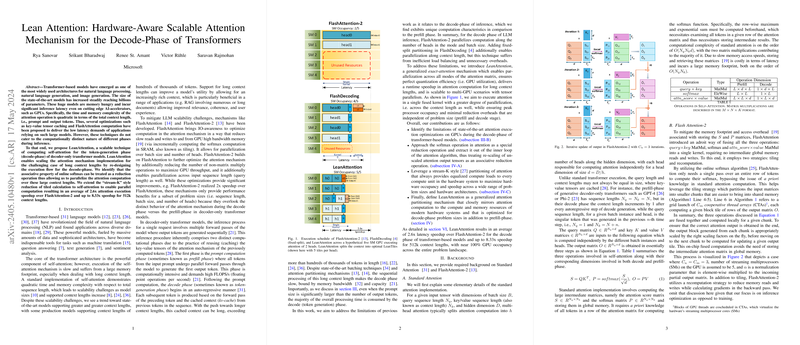LeanAttention: Speeding Up Attention Mechanisms for Transformer Models
Background
In the field of AI and NLP, transformer-based models have become extremely valuable due to their performance on tasks such as text generation, machine translation, and sentiment analysis. These transformers, with self-attention mechanisms at their heart, require significant memory and computation power, particularly as contexts lengthen and models scale up to billions of parameters.
The Challenge
The real bottleneck in transformer models arises during the attention mechanism, especially when dealing with lengthy contexts. Execution time and memory usage for this process grow quadratically with sequence length. To mitigate this problem, approaches like FlashAttention and FlashAttention-2 optimize memory and computational efficiency. However, these techniques often overlook the unique computational demands of the two main phases of transformer inference: the prefill phase (where the model processes the input prompt) and the decode phase (where the model generates tokens sequentially).
Introducing LeanAttention
LeanAttention is proposed as an innovative technique to optimize the attention mechanism during the decode phase of decoder-only transformer models. The decode phase is notoriously challenging due to its sequential nature and the necessity to handle extensive context lengths efficiently. LeanAttention exploits the associative properties of the attention mechanism to achieve significant performance gains.
Critical Concepts Behind LeanAttention
1. Softmax Re-scaling as a Reduction Operation
LeanAttention reconceptualizes the softmax operation involved in attention as a form of reduction. By treating re-scaling of un-scaled attention output tensors as an associative reduction operation, LeanAttention enables parallel computation over large context lengths. This is crucial for handling decode-phase workloads effectively.
2. Stream-K Style Decomposition
Taking inspiration from optimized matrix multiplication strategies in GPU computing, LeanAttention divides the attention tasks into minimal computational units called LeanTiles. It then efficiently distributes these lean tiles across the available processing units, ensuring balanced workloads and maximizing hardware utilization. Unlike previous methods, LeanAttention maintains near 100% GPU occupancy regardless of the problem size.
Performance Gains
LeanAttention has demonstrated impressive speedups in the attention execution process. In benchmark tests, LeanAttention achieved:
- An average speedup of 2.6x over FlashAttention-2.
- Up to 8.33x speedup for very long context lengths (512k tokens).
Additionally, in multi-GPU environments, it showed even greater gains, confirming its scalability and efficiency for large-scale AI models.
Practical and Theoretical Implications
Practical Implications
LeanAttention's capability to handle lengthy contexts efficiently means that transformer-based models can now support richer, more coherent interactions. This improvement is particularly beneficial for applications requiring long contextual understanding, such as document search and retrieval, dialogue systems, and large-scale content generation.
- Reduced Latency: By cutting down the execution time, LeanAttention facilitates faster responses in real-time applications.
- Enhanced Scalability: It supports the ongoing trend of increasing model sizes and context lengths without compromising performance.
Theoretical Implications
From a theoretical perspective, LeanAttention contributes to the understanding of how matrix decomposition and associative properties in computations can be leveraged to optimize complex machine learning operations. It suggests directions for further research, such as exploring similar optimizations for other phases of model inference or extending these principles to other types of models.
What's Next?
LeanAttention opens up numerous avenues for future research and development in AI:
- Integrating with Larger Models: Applying LeanAttention to even larger transformers and comparing its performance across different architectures.
- Extending to Other Phases: Investigating how the associative property and Stream-K decomposition can optimize other inference phases or even training processes.
- Multi-GPU and Distributed Systems: Further optimizing LeanAttention for more complex hardware setups, enabling seamless scalability across distributed systems.
Conclusion
LeanAttention presents a significant advance in the efficient execution of the attention mechanism within transformer-based models, particularly during the decode phase. By rethinking the softmax operation and utilizing a novel decomposition strategy, LeanAttention offers substantial performance improvements and provides a robust framework for scaling up transformer models in the future. Whether you're working with extensive text generation tasks or building models that require deep contextual understanding, LeanAttention is a step forward in making large-scale NLP more efficient and scalable.
